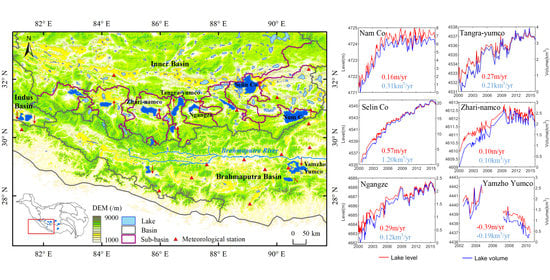Changing Patterns of Lakes on The Southern Tibetan Plateau Based on Multi-Source Satellite Data
Abstract
1. Introduction
2. Study Area
3. Data and Methods
3.1. Data
3.1.1. MODIS Images
3.1.2. Altimeter Data
3.1.3. Hydroweb
3.1.4. Meteorological Data
3.2. Method
3.2.1. Inundation Extraction
3.2.2. Water Level
3.2.3. Lake Storage Changes
4. Results and Analysis
4.1. Fluctuation of the Water Surface
4.2. Lake Level and Volume
5. Discussion
5.1. Accuracy Assessment
5.2. Driving Forces
6. Conclusions
Author Contributions
Funding
Conflicts of Interest
References
- Sun, F.; Zhao, Y.; Gong, P.; Ma, R.; Dai, Y. Monitoring dynamic changes of global land cover types: Fluctuations of major lakes in China every 8 days during 2000–2010. Chin. Sci. Bull. 2014, 59, 171–189. [Google Scholar] [CrossRef]
- Zhang, G.; Xie, H.; Yao, T.; Kang, S. Water balance estimates of ten greatest lakes in China using ICESat and Landsat data. Chin. Sci. Bull. 2013, 58, 3815–3829. [Google Scholar] [CrossRef]
- Zhang, G.; Yao, T.; Shum, C.K.; Yi, S.; Yang, K.; Xie, H.; Feng, W.; Bolch, T.; Wang, L.; Behrangi, A. Lake volume and groundwater storage variations in Tibetan Plateau’s endorheic basin. Geophys. Res. Lett. 2017, 44, 5550–5560. [Google Scholar] [CrossRef]
- Alsdorf, D.E.; Rodríguez, E.; Lettenmaier, D.P. Measuring surface water from space. Rev. Geophys. 2007, 45. [Google Scholar] [CrossRef]
- Smith, L.C. Satellite remote sensing of river inundation area, stage, and discharge: A review. Hydrol. Process. 1997, 11, 1427–1439. [Google Scholar] [CrossRef]
- Birkett, C.M. The contribution of TOPEX/POSEIDON to the global monitoring of climatically sensitive lakes. J. Geophys. Res. Oceans. 1995, 100, 25179–25204. [Google Scholar] [CrossRef]
- Birkett, C.M.; Mertes, L.; Dunne, T.; Costa, M.H.; Jasinski, M.J. Surface water dynamics in the Amazon Basin: Application of satellite radar altimetry. J. Geophys. Res. Atmos. 2002, 107, 21–26. [Google Scholar] [CrossRef]
- Hwang, C.; Peng, M.; Ning, J.; Luo, J.; Sui, C. Lake level variations in China from TOPEX/Poseidon altimetry: Data quality assessment and links to precipitation and ENSO. Geophys. J. Int. 2005, 161, 1–11. [Google Scholar] [CrossRef]
- Zheng, J.; Ke, C.; Shao, Z.; Li, F. Monitoring changes in the water volume of Hulun Lake by integrating satellite altimetry data and Landsat images between 1992 and 2010. J. Appl. Remote Sens. 2016, 10, 16029. [Google Scholar] [CrossRef]
- Wang, X.; Gong, P.; Zhao, Y.; Xu, Y.; Cheng, X.; Niu, Z.; Luo, Z.; Huang, H.; Sun, F.; Li, X. Water-level changes in China’s large lakes determined from ICESat/GLAS data. Remote Sens. Environ. 2013, 132, 131–144. [Google Scholar] [CrossRef]
- Schwatke, C.; Dettmering, D.; Bosch, W.; Seitz, F. DAHITI – an innovative approach for estimating water level time series over inland waters using multi-mission satellite altimetry. Hydrol. Earth Syst. Sci. 2015, 19, 4345–4364. [Google Scholar] [CrossRef]
- Birkett, C.; Reynolds, C.; Beckley, B.; Doorn, B. From Research to Operations: The USDA Global Reservoir and Lake Monitor; Coastal Altimetry; Springer: Berlin/Heidelberg, Germany, 2011; pp. 19–50. [Google Scholar]
- Berry, P.A.M.; Wheeler, J.L. JASON2-ENVISAT Exploitation—Development of Algorithms for the Exploitation of JASON2-ENVISAT Altimetry for the Generation of a River and Lake Product; Product Handbook v3.5; De Montfort University: Leicester, UK, 2009. [Google Scholar]
- Crétaux, J.; Jelinski, W.; Calmant, S.; Kouraev, A.; Vuglinski, V.; Bergé-Nguyen, M.; Gennero, M.; Nino, F.; Del Rio, R.A.; Cazenave, A. SOLS: A lake database to monitor in the Near Real Time water level and storage variations from remote sensing data. Adv. Space Res. 2011, 47, 1497–1507. [Google Scholar] [CrossRef]
- Prigent, C.; Papa, F.; Aires, F.; Rossow, W.B.; Matthews, E. Global inundation dynamics inferred from multiple satellite observations, 1993–2000. J. Geophys. Res. Atmos. 2007, 112. [Google Scholar] [CrossRef]
- Papa, F.; Prigent, C.; Aires, F.; Jimenez, C.; Rossow, W.B.; Matthews, E. Interannual variability of surface water extent at the global scale, 1993–2004. J. Geophys. Res. Atmos. 2010, 115. [Google Scholar] [CrossRef]
- Feng, L.; Hu, C.; Chen, X.; Li, R.; Tian, L.; Murch, B. MODIS observations of the bottom topography and its inter-annual variability of Poyang Lake. Remote Sens. Environ. 2011, 115, 2729–2741. [Google Scholar] [CrossRef]
- Frappart, F.; Seyler, F.; Martinez, J.; León, J.G.; Cazenave, A. Floodplain water storage in the Negro River basin estimated from microwave remote sensing of inundation area and water levels. Remote Sens. Environ. 2005, 99, 387–399. [Google Scholar] [CrossRef]
- Song, C.; Huang, B.; Ke, L. Modeling and analysis of lake water storage changes on the Tibetan Plateau using multi-mission satellite data. Remote Sens. Environ. 2013, 135, 25–35. [Google Scholar] [CrossRef]
- Cai, X.; Feng, L.; Hou, X.; Chen, X. Remote sensing of the water storage dynamics of large lakes and reservoirs in the Yangtze River Basin from 2000 to 2014. Sci. Rep.-UK 2016, 6, 36405. [Google Scholar] [CrossRef]
- Sun, F.; Ma, R. Hydrologic changes of Aral Sea: A reveal by the combination of radar altimeter data and optical images. Ann. GIS 2019, 25, 247–261. [Google Scholar] [CrossRef]
- Medina, C.; Gomez-Enri, J.; Alonso, J.J.; Villares, P. Water volume variations in Lake Izabal (Guatemala) from in situ measurements and ENVISAT Radar Altimeter (RA-2) and Advanced Synthetic Aperture Radar (ASAR) data products. J. Hydrol. 2010, 382, 34–48. [Google Scholar] [CrossRef]
- Swenson, S.; Wahr, J. Monitoring the water balance of Lake Victoria, East Africa, from space. J. Hydrol. 2009, 370, 163–176. [Google Scholar] [CrossRef]
- Vapnik, V. Estimation of Dependences Based on Empirical Data; Springer Science & Business Media: New York, NY, USA, 2006. [Google Scholar]
- Feyisa, G.L.; Meilby, H.; Fensholt, R.; Proud, S.R. Automated Water Extraction Index: A new technique for surface water mapping using Landsat imagery. Remote Sens. Environ. 2014, 140, 23–35. [Google Scholar] [CrossRef]
- Bronner, E.; Guillot, A.; Picot, N.; Noubel, J. SARAL/AltiKa products handbook. Tech. Rep. CNES SALP-MU-M-OP-15984-CN 2013, 2, 1–76. [Google Scholar]
- Liu, Y.; Yue, H. Estimating the fluctuation of Lake Hulun, China, during 1975–2015 from satellite altimetry data. Environ. Monit. Assess. 2017, 189, 1–16. [Google Scholar] [CrossRef]
- Zhang, G.; Chen, W.; Xie, H. Tibetan Plateau’s lake level and volume changes from NASA’s ICESat/ICESat-2 and Landsat Missions. Geophys. Res. Lett. 2019, 46, 13107–13118. [Google Scholar] [CrossRef]
- Zhang, G.; Yao, T.; Xie, H.; Zhang, K.; Zhu, F. Lakes’ state and abundance across the Tibetan Plateau. Chin. Sci. Bull. 2014, 59, 3010–3021. [Google Scholar] [CrossRef]
- Li, X.; Long, D.; Huang, Q.; Han, P.; Zhao, F.; Wada, Y. High-temporal-resolution water level and storage change data sets for lakes on the Tibetan Plateau during 2000–2017 using multiple altimetric missions and Landsat-derived lake shoreline positions. Earth Syst. Sci. Data Discuss. 2019, 11, 1603–1627. [Google Scholar] [CrossRef]
- Allen, R.G.; Pereira, L.S.; Raes, D.; Smith, M. Crop Evapotranspiration-Guidelines for Computing Crop Water Requirements-FAO Irrigation and Drainage paper 56; Food and Agriculture Organization of the United Nations: Rome, Italy, 1998. [Google Scholar]
- Sang, Y.F.; Chen, D.; Gong, T. What Caused the Decline of Water Level of Yamzho Yumco During 1975–2012 in the Southern Tibetan Plateau? J. Geophhys Res-Atmos. 2020, 125, e31121. [Google Scholar] [CrossRef]
- Biancamaria, S.; Lettenmaier, D.P.; Pavelsky, T.M. The SWOT mission and its capabilities for land hydrology. Surv. Geophys. 2016, 37, 307–337. [Google Scholar] [CrossRef]
- Xie, Z.; Yuan, F.; Duan, Q.; Zheng, J.; Liang, M.; Chen, F. Regional parameter estimation of the VIC land surface model: Methodology and application to river basins in China. J. Hydrometeorol. 2007, 8, 447–468. [Google Scholar] [CrossRef]
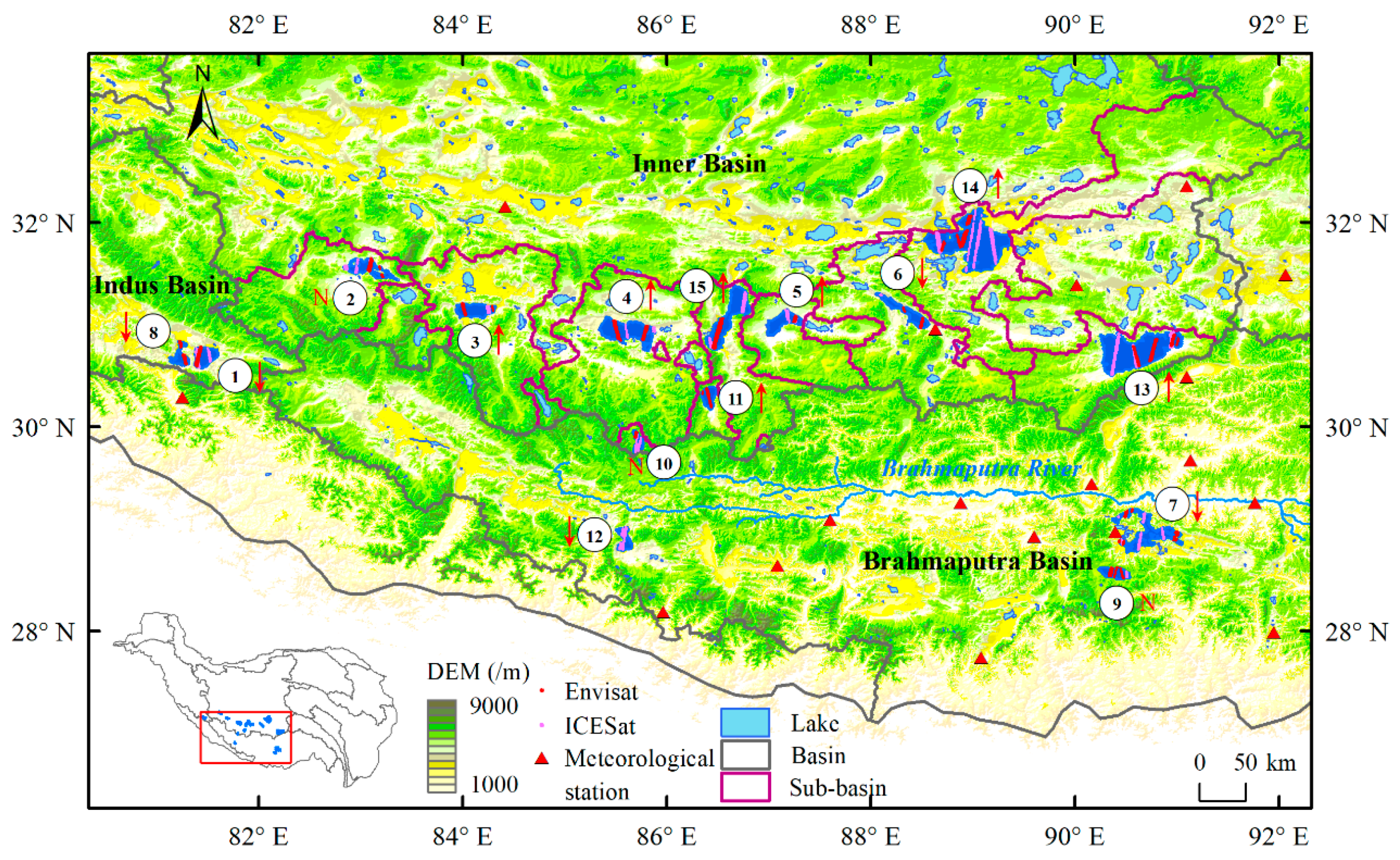



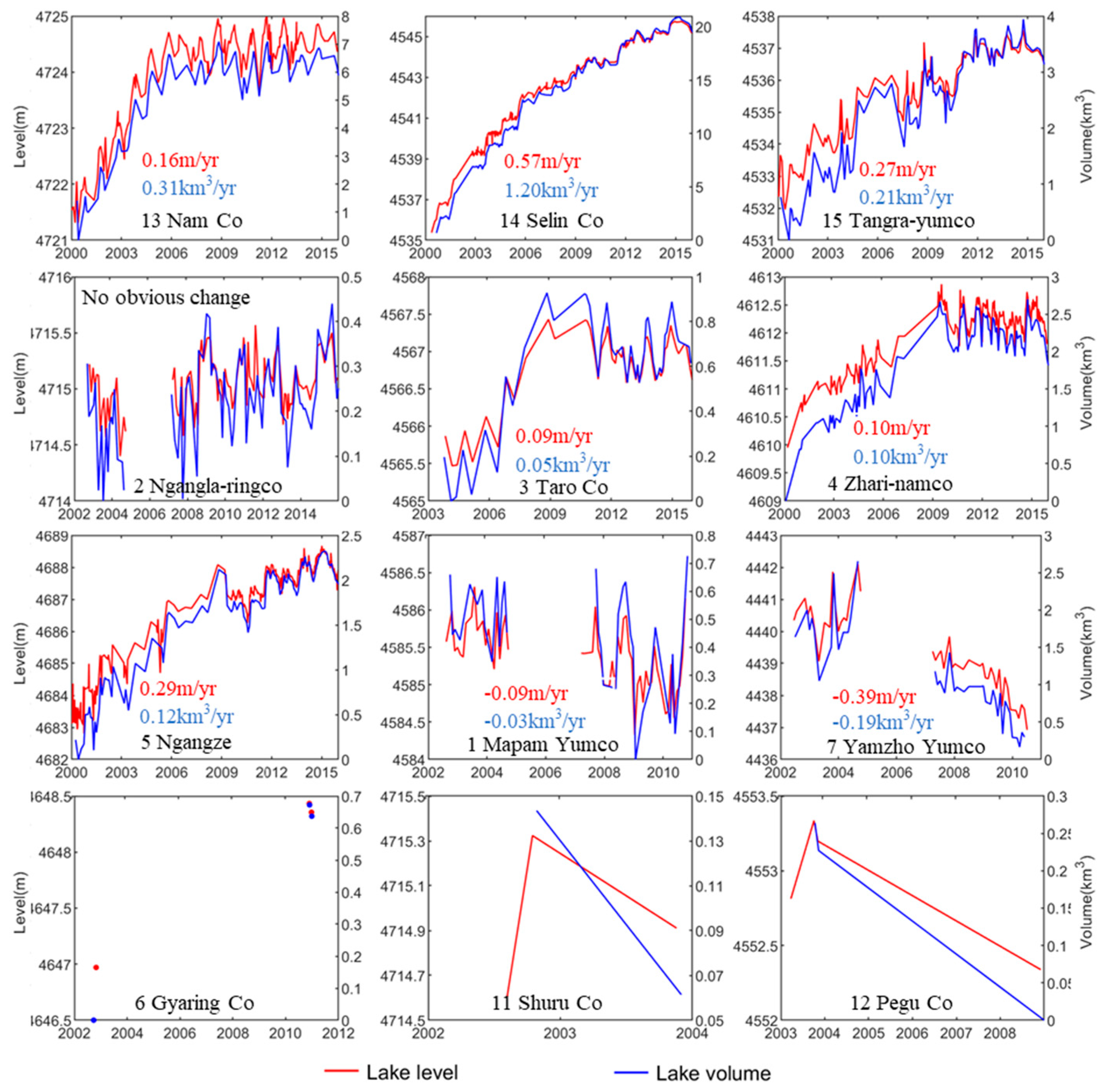

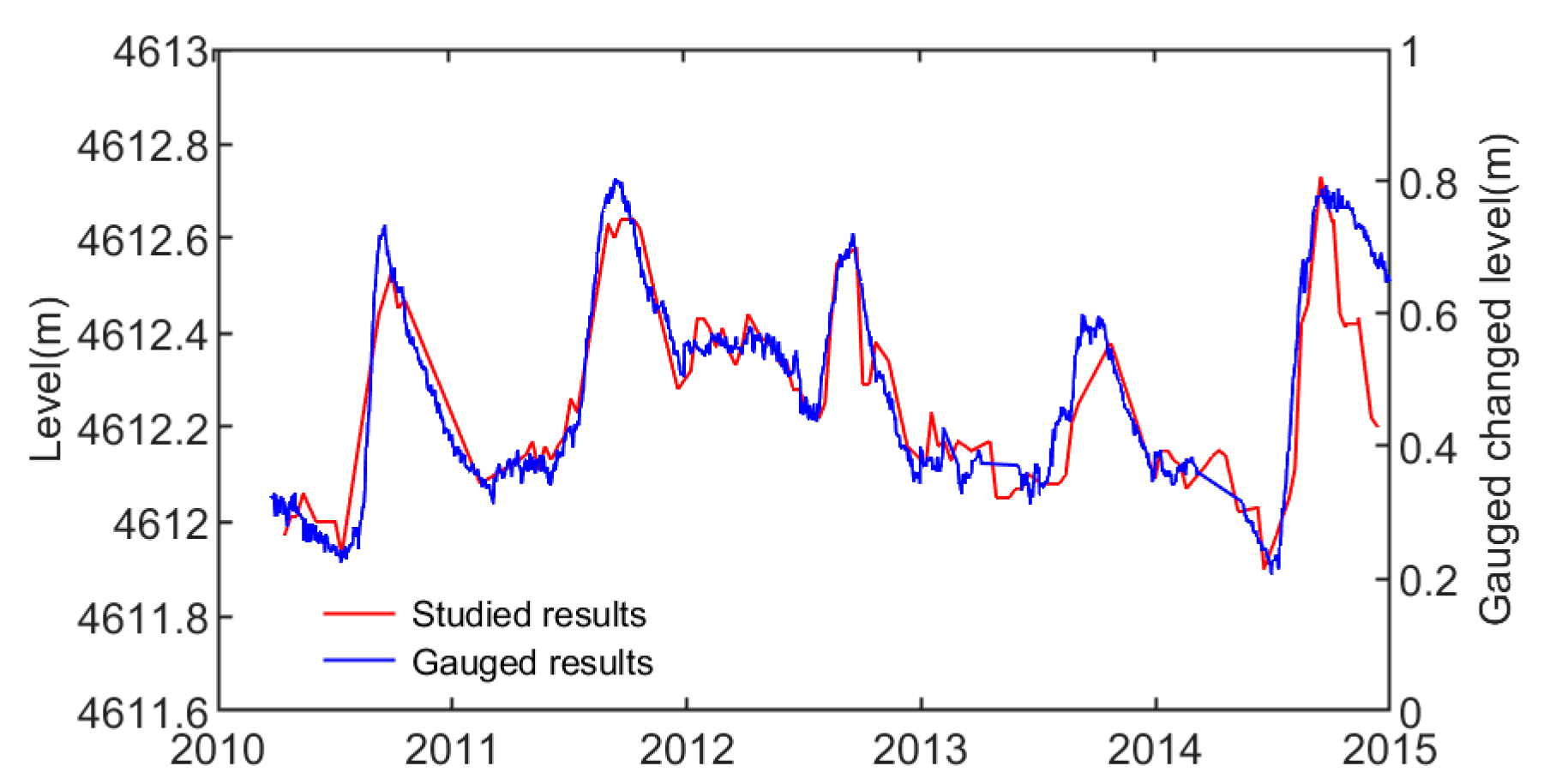
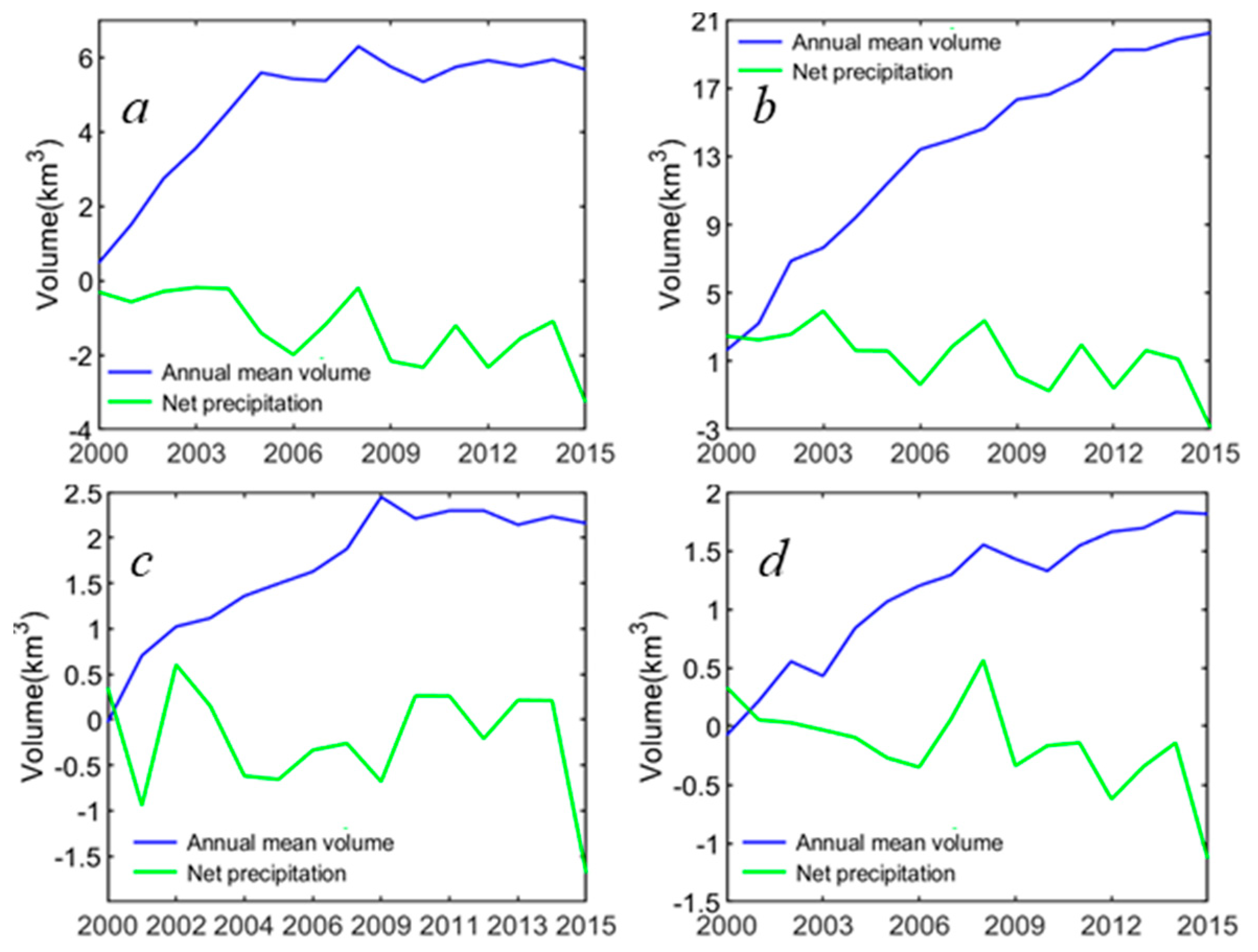

| Lake ID | Name | Longitude 1 (°) | Latitude 1 (°) | Area (km2) | Level (m) |
|---|---|---|---|---|---|
| 1 | Mapam Yumco | 81.42 | 30.75 | 401.47 | 4585.39 |
| 2 | Ngangla-ringco | 83.09 | 31.56 | 485.83 | 4715.03 |
| 3 | Taro Co | 84.12 | 31.13 | 473.50 | 4566.77 |
| 4 | Zhari-namco | 85.62 | 30.91 | 985.65 | 4612.48 |
| 5 | Ngangze | 87.15 | 31.03 | 437.03 | 4683.00 |
| 6 | Gyaring Co | 88.31 | 31.13 | 460.44 | 4648.23 |
| 7 | Yamzho Yumco | 90.65 | 28.88 | 506.84 | 4439.36 |
| 8 | Rakshastal | 81.25 | 30.66 | 247.24 | 4572.00 |
| 9 | Puma Yumco | 90.38 | 28.57 | 281.75 | 5017.28 |
| 10 | Daggayai Co | 85.72 | 29.85 | 101.36 | 5143.80 |
| 11 | Shuru Co | 86.41 | 30.27 | 200.64 | 4714.95 |
| 12 | Pegu Co | 85.60 | 28.90 | 264.95 | 4580.00 |
| 13 | Nam Co | 90.66 | 30.72 | 1971.81 | 4723.64 |
| 14 | Selin Co | 88.95 | 31.76 | 2192.24 | 4542.59 |
| 15 | Tangra-yumco | 86.60 | 31.06 | 817.60 | 4535.83 |
| Lake ID | Area | Level | |||||
|---|---|---|---|---|---|---|---|
| Number of Series | Time Range | Data Source 2 | Number of Series | Time Range | |||
| Hydroweb | Envisat | ICESat | |||||
| 1 | 369 | 2000/3/5–2015/12/17 | √ | √ | 53 | 2002/8/12–2010/10/3 | |
| 2 | 406 | 2000/2/26–2015/12/17 | √ | √ | √ | 107 | 2002/10/19–2015/12/7 |
| 3 | 501 | 2000/2/26–2015/12/17 | √ | √ | √ | 55 | 2003/11/1–2015/12/27 |
| 4 | 500 | 2000/3/5–2015/12/17 | √ | √ | √ | 256 | 2000/3/6–2015/12/23 |
| 5 | 411 | 2000/3/5–2015/12/17 | √ | √ | √ | 308 | 2000/1/6–2015/12/23 |
| 6 | 465 | 2000/3/5–2015/12/17 | √ | √ | 12 | 2002/7/15–2011/12/18 | |
| 7 | 573 | 2000/2/18–2015/12/17 | √ | √ | 45 | 2002/6/17–2010/7/5 | |
| 8 | 366 | 2000/5/16–2015/12/17 | √ | 3 | 2002/7/30–2003/4/1 | ||
| 9 | 395 | 2000/2/18–2015/12/17 | √ | √ | 20 | 2002/7/12–2012/3/20 | |
| 10 | 369 | 2000/2/26–2015/12/17 | √ | 14 | 2010/11/20–2012/3/13 | ||
| 11 | 445 | 2000/2/26–2015/12/17 | √ | 3 | 2002/8/6–2003/11/17 | ||
| 12 | 499 | 2000/2/26–2015/12/17 | √ | 4 | 2003/3/24–2008/12/2 | ||
| 13 | 322 | 2000/2/18–2015/12/17 | √ | √ | √ | 158 | 2000/1/9–2015/12/8 |
| 14 | 453 | 2000/4/6–2015/12/17 | √ | √ | √ | 251 | 2000/5/16–2015/12/30 |
| 15 | 410 | 2000/2/26–2015/12/17 | √ | √ | √ | 133 | 2000/1/18–2015/12/17 |
| Lake ID. | 1 | 2 | 3 | 4 | 5 | 6 | 7 | 8 | 9 | 10 | 11 | 12 | 13 | 14 | 15 |
|---|---|---|---|---|---|---|---|---|---|---|---|---|---|---|---|
| Lake Name | Mapam Yumco | Ngangla-Ringco | Taro Co | Zhari-Namco | Ngangze | Gyaring Co | Yamzho Yumco | Rakshastal | Puma Yumco | Daggayai Co | Shuru Co | Pegu Co | Nam Co | Selin Co | Tangra-Yumco |
| Basin | Indus | Inner | Inner | Inner | Inner | Inner | Brahmaputra | Indus | Brahmaputra | Inner | Inner | Brahmaputra | Inner | Inner | Inner |
| Max area (km2)/Date | 413.43 | 514.54 | 484.7 | 1019.84 | 470.75 | 479.55 | 587.09 | 259.95 | 296.23 | 109.69 | 206.5 | 274.55 | 2042.48 | 2377.99 | 848.33 |
| 2006/11/1 | 2008/12/26 | 2009/3/6 | 2010/2/2 | 2015/3/22 | 2004/10/31 | 2004/10/31 | 2000/9/29 | 2015/11/1 | 2009/1/25 | 2002/1/9 | 2005/11/17 | 2008/10/31 | 2013/11/1 | 2011/3/14 | |
| Min area (km2)/Date | 390.68 | 461.95 | 463.02 | 940.85 | 384.24 | 439.19 | 402.49 | 233.33 | 268.11 | 91.87 | 194.05 | 254.8 | 1889.21 | 1805.71 | 792.52 |
| 2010/5/25 | 2002/6/10 | 2014/6/26 | 2000/4/30 | 2000/7/19 | 2008/6/1 | 2015/6/10 | 2008/6/17 | 2005/7/28 | 2015/7/4 | 2008/9/29 | 2009/4/15 | 2000/7/11 | 2000/6/17 | 2001/8/21 | |
| Changing rate (km2/yr) | –0.10 | No change | 0.15 | 2.27 | 3.70 | −0.16 | −3.49 | −0.36 | No change | No change | 0.05 | −0.18 | 1.62 | 28.81 | 0.61 |
| p-value < 0.05 | Y | N | Y | Y | Y | Y | Y | Y | N | N | Y | Y | Y | Y | Y |
| Lake | Precipitation (km3) | Runoff (km3) | Evapotranspiration (km3) | W (km3) |
|---|---|---|---|---|
| Nam Co | 0.91 | 3.52 | 2.51 | 1.68 |
| Selin Co | 0.94 | 11.46 | 3.04 | 0.08 |
| Zhari-namco | 0.28 | 6.37 | 1.07 | 0.42 |
| Ngangze | 0.12 | 2.36 | 0.44 | 0.32 |
Publisher’s Note: MDPI stays neutral with regard to jurisdictional claims in published maps and institutional affiliations. |
© 2020 by the authors. Licensee MDPI, Basel, Switzerland. This article is an open access article distributed under the terms and conditions of the Creative Commons Attribution (CC BY) license (http://creativecommons.org/licenses/by/4.0/).
Share and Cite
Sun, F.; Ma, R.; He, B.; Zhao, X.; Zeng, Y.; Zhang, S.; Tang, S. Changing Patterns of Lakes on The Southern Tibetan Plateau Based on Multi-Source Satellite Data. Remote Sens. 2020, 12, 3450. https://doi.org/10.3390/rs12203450
Sun F, Ma R, He B, Zhao X, Zeng Y, Zhang S, Tang S. Changing Patterns of Lakes on The Southern Tibetan Plateau Based on Multi-Source Satellite Data. Remote Sensing. 2020; 12(20):3450. https://doi.org/10.3390/rs12203450
Chicago/Turabian StyleSun, Fangdi, Ronghua Ma, Bin He, Xiaoli Zhao, Yuchao Zeng, Siyi Zhang, and Shilin Tang. 2020. "Changing Patterns of Lakes on The Southern Tibetan Plateau Based on Multi-Source Satellite Data" Remote Sensing 12, no. 20: 3450. https://doi.org/10.3390/rs12203450
APA StyleSun, F., Ma, R., He, B., Zhao, X., Zeng, Y., Zhang, S., & Tang, S. (2020). Changing Patterns of Lakes on The Southern Tibetan Plateau Based on Multi-Source Satellite Data. Remote Sensing, 12(20), 3450. https://doi.org/10.3390/rs12203450






